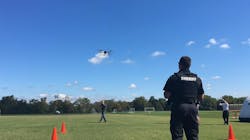Drone Surveillance is Swiftly Becoming a Game Changer for Missing Persons Cases
By: Olga Megorskaya, Founder and CEO, Toloka AI
Missing persons cases are among some of the most challenging. As a member of law enforcement, you know what you’re expected to do, but it’s often easier said than done, no matter your dedication and diligence. What’s the plan when there are no apparent leads, only expansive areas that need to be searched quickly?
As anyone involved in a missing person case will tell you—be it a police officer, forest ranger, SAR member, or case volunteer—it all comes down to planning strategically, coordinating joint efforts, and making use of the right tools. In this day and age, all three are intimately linked with technology: more specifically, drone surveillance that has become an indispensable asset to cracking these cases.
Surveillance drones and data collection
Drones, otherwise known as UAS (Unmanned Aircraft Systems), are facilitating surveillance across the U.S. already. For example, the Loudoun County Sheriff's Office in Virginia grew disillusioned with having to request helicopter assistance from Fairfax to look for missing persons. The now obsolete air support strategy proved extremely ineffective—the helicopter had to arrive from afar and refuel constantly, resulting in painstakingly slow progress.
After some deliberating, the Sheriff's Office purchased an Indago drone by Lockheed Martin that could be deployed for search within 2 minutes. The drone also proved more agile than a helicopter, being capable of entering narrower and harder-to-reach spaces closer to the ground. When another Sheriff’s Office from the nearby Shenandoah County along with Virginia Department of Emergency Management requested assistance in locating a hunter who’d gone missing in the mountains, the drone was deployed for the first time and found the missing man within 20 minutes of launch.
Another successful drone deployment example comes from North Dakota where the police department in the city of Minot used a Skyskopes drone to locate a missing two-year-old boy. He was quickly located in an unoccupied house. In addition to using drones to help fight wildfires, floods, and tornadoes, Minot is now utilizing this new technology for “missing person searches, active shooter incidents, and crowd monitoring,” said Police Chief John Klug.
Likewise in Connecticut, as a result of the recently launched grant-funded drone program, Hartford Police Department managed to find a missing 8-year-old. This job would have probably taken 20 officers, said Police Chief Jason Thod. With the new UAS devices at the department's disposal, scanning for missing persons across large areas like the Connecticut River has become a totally different game, he explained.
Hartford Police Department has also started to deploy drones to track stolen vehicles in lieu of engaging in dangerous high-speed chases. After consulting the Federal Aviation Administration, a special training program for Hartford police officers was put in place that included six weeks of hands-on training and an exam to get the drone pilot’s license.
As far as the cases from outside the US, according to researchers from the American University of Rome, a Goolsky Zerotech Dobby drone was recently used to solve a case involving two missing persons that turned out to be a double homicide. Following the trail of the two individuals who had gone missing, law enforcement officials used the drone to search the area and eventually stumbled upon a property that contained four out-of-place, abnormal-looking patches on the ground.
This led to a search warrant and a subsequent excavation that uncovered two human corpses inside two of the four clandestine pits. The other two—the apprehended admitted—were created artificially to throw off the investigation.
Post-surveillance data labeling
The aforementioned are all successful cases. However, so far we’ve only been looking at one side of drone surveillance—data collection. In reality, to effectively aid missing person cases, having drones and accompanying navigation equipment isn’t enough. The reason is that it’s not always possible to track people in real time. And with a large volume of raw and often noisy drone imagery at hand, finding a missing person can often feel like finding a needle in a haystack. As a result, it comes down not just to viewing search data in real time (though sometimes we get lucky) but to collecting this data and then processing or “labeling” it, to use the technical term, post-deployment.
To understand the importance of this in action, consider the following case from overseas. Liza Alert is a non-profit organization that consists of volunteers who search for missing persons across Eastern Europe and Central Asia. In the 10 years of its operations, Liza Alert has conducted over 100,000 searches and more than 85,000 people have been found.
Last year the organization's partnered with Toloka, a data-labeling platform that utilizes the power of crowdsourcing. Crowdsourcing is a type of labeling methodology that’s based on recruiting a large number of human labelers from all over the globe and then aggregating their efforts.
In this scenario, anyone can be a labeler after a short training session as long as experienced data managers—the so-called crowd solution architects—are there to coordinate and synchronize the output of every individual contributor. This strategy differs sharply from the older tactic of using a small group of narrowly specialized in-house labeling specialists, which is a more costly endeavor, both time- and money-wise.
The way it works is Liza Alert teams use drones to search for missing persons on-site—often in the densely forested wilderness or secluded rural areas—and then the imagery is passed on to data labelers (“crowd performers”) for further processing.
As of 2021, these crowd performers processed 330,591 drone images collected by Liza Alert. Of those images, 49,041 were judged to contain people, which in turn led to 214 searches. Every 500 images uploaded by Liza Alert saves the latter up to 8 hours from 3 to 5 of its volunteers. This means that Liza Alert’s use of drone surveillance data labeling saved the rescue organization a whopping 330 working days last year alone.
Key takeaway
In conclusion, drone surveillance has become a game changer for missing person cases. We’ve seen a number of successful efforts within the US when drones were deployed, leading to finding those missing. However, while UAS devices are becoming more ubiquitous within law enforcement, knowing how to label their data quickly and efficiently remains a hurdle.
While law enforcement agencies as well as SAR organizations in other parts of the world are beginning to utilize modern data-labeling methodologies more frequently, local law enforcement in the US is lagging behind somewhat. Granted, these methodologies exist at the federal level in America and some are already being used by the military. Nevertheless, this isn’t yet the case at the state and municipal levels where most search efforts are actually carried out.
Using accessible human-handled data-labeling methods, such as crowdsourcing, to process drone surveillance imagery is one of the most affordable ways to make large-scale search efforts more successful. Importantly, this can be achieved without putting additional strain on the law enforcement agencies themselves, that is without diverging precious resources from where they’re most needed on the ground.About the Author
Olga Megorskaya is the founder & CEO at Toloka AI, a global data labeling solution. Previously, Olga developed data production infrastructure and implemented effective use of crowdsourced data labeling for ML-based products such as search, maps, voice assistants, self-driving cars, and more. Olga is a co-author of research papers on efficient crowdsourcing and quality control and spoke at a number of top science conferences such as NeurIps, ICML, VLDB. In 2022, Olga was featured in VentureBeat, Entrepreneur, Bloomberg, as well as in the leading ML/AI publications.

